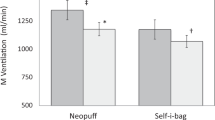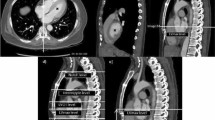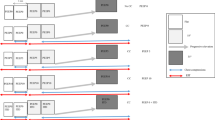Abstract
Objective:
To compare the proportion of correct placements (POCP) between ‘two-fingers’ and ‘two-thumbs’ techniques of chest compression among neonates of various gestations.
Study Design:
Two-fingers and two-thumbs spans of 32 adult rescuers were individually compared with the inter-nipple line to sterno-xiphoid junction distance of 39 neonates. ‘Correct placement’ was defined if two-fingers/two-thumbs span was equal to or less than the inter-nipple line to sterno-xiphoid junction distance. The POCPs was compared between two-fingers and two-thumbs methods of chest compression by the McNemar test among neonates and their various subgroups.
Result:
There were a total of 1248 comparisons. The POCPs with two-fingers and two-thumbs techniques were 6.7 and 77% in all neonates, 10.6 and 89.5% in full term and 1.2 and 59% in preterm neonates, respectively (P<0.001).
Conclusion:
Two-thumbs technique achieved higher POCPs and should be preferred over two-fingers technique among neonates.
This is a preview of subscription content, access via your institution
Access options
Subscribe to this journal
Receive 12 print issues and online access
$259.00 per year
only $21.58 per issue
Buy this article
- Purchase on Springer Link
- Instant access to full article PDF
Prices may be subject to local taxes which are calculated during checkout

Similar content being viewed by others
References
Kattwinkel J, Perlman JM, Aziz K, Colby C, Fairchild K, Gallagher J et al. Circulation 2010; 122: S909–S919.
Menegazzi JJ, Auble TE, Nicklas KA, Hosack GM, Rack L, Goode JS . Two-thumb versus two-finger chest compression during CRP in a swine infant model of cardiac arrest. Ann Emerg Med 1993; 22: 240–243.
Houri PK, Frank LR, Menegazzi JJ, Taylor R . A randomized, controlled trial of two-thumb vs two-finger chest compression in a swine infant model of cardiac arrest. Prehosp Emerg Care 1997; 1: 65–67.
Udassi JP, Udassi S, Theriaque DW, Shuster JJ, Zaritsky AL, Haque IU . Effect of alternative chest compression techniques in infant and child on rescuer performance. Pediatr Crit Care Med 2009; 10: 328–333.
Christman C, Hemway RJ, Wyckoff MH, Perlman JM . The two-thumb is superior to the two-finger method for administering chest compressions in a manikin model of neonatal resuscitation. Arch Dis Child Fetal Neonatal Ed 2011; 96: F99–F101.
David R . Closed chest cardiac massage in the newborn infant. Pediatrics 1988; 81: 552–554.
Thaler MM, Stobie GH . An improved technique of external cardiac compression in infants and young children. N Engl J Med 1963; 269: 606–610.
Phillips GWL, Zideman DA . Relation of the infant heart to sternum: its significance in cardiopulmonary resuscitation. Lancet 1986; 1: 1024–1025.
Orlowski JP . Optimum position for external cardiac compression in infants and young children. Ann Emerg Med 1986; 5: 667–673.
Finholt DA, Kettick RG, Wagner HR, Swedlow DB . The heart is under the lower one third of the sternum. Am J Dis Child 1986; 140: 646–649.
Thaler MM, Krause VW . Serious trauma in children after external cardiac massage. New Engl J Med 1962; 267: 500.
Clements F, McGowan J . Finger position for chest compressions in cardiac arrest in infants. Resuscitation 2000; 44: 43–46.
Lubchenco LO, Hansman C, Boyd E . Intrauterine growth in length and head circumference as estimated from live births at gestational ages from 26 to 42 weeks. Pediatrics 1966; 37: 403–408.
Sivan Y, Merlob P, Reisner SH . Sternal length, torso length, and internipple distance in newborn infants. Pediatrics 1983; 72: 523–525.
Dorfsman ML, Menegazzi JJ, Wadas RJ, Auble TE . Two-thumb vs two-finger chest compression in an infant model of prolonged cardiopulmonary resuscitation. Acad Emerg Med 2000; 7: 1077–1082.
Whitelaw CC, Slywka B, Goldsmith LJ . Comparison of a two-finger versus two-thumb method for chest compressions by healthcare providers in an infant mechanical model. Resuscitation 2000; 43: 213–216.
Author information
Authors and Affiliations
Corresponding author
Ethics declarations
Competing interests
The authors declare no conflict of interest.
Additional information
Authors contribution
Shiv Sajan Saini conceived the idea, planned the study, did statistical analysis and wrote the initial draft. Neeraj Gupta extracted, analyzed and summarized the data. Praveen Kumar planned the study, supervised data analysis, revised the manuscript critically for important intellectual content and finalized the manuscript. Anil Kumar Bhalla planned the measurement methods and revised the manuscript for important intellectual content. Harvinder Kaur performed anthropometrical measurements and helped in writing the initial draft.
Rights and permissions
About this article
Cite this article
Saini, S., Gupta, N., Kumar, P. et al. A comparison of two-fingers technique and two-thumbs encircling hands technique of chest compression in neonates. J Perinatol 32, 690–694 (2012). https://doi.org/10.1038/jp.2011.167
Received:
Revised:
Accepted:
Published:
Issue Date:
DOI: https://doi.org/10.1038/jp.2011.167
Keywords
This article is cited by
-
Effect of two different chest compression techniques on ventilation during neonatal resuscitation
Journal of Perinatology (2021)
-
Versorgung und Reanimation des Neugeborenen nach der Geburt
Notfall + Rettungsmedizin (2021)
-
Neonatal resuscitation: evolving strategies
Maternal Health, Neonatology and Perinatology (2015)
-
Die Versorgung und Reanimation des Neugeborenen
Notfall + Rettungsmedizin (2015)
-
Kurzdarstellung
Notfall + Rettungsmedizin (2015)



